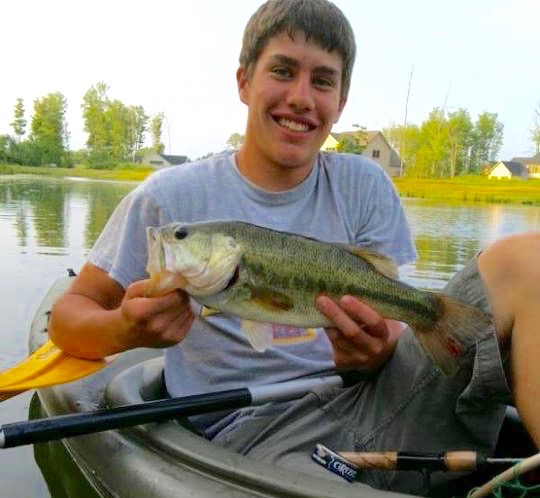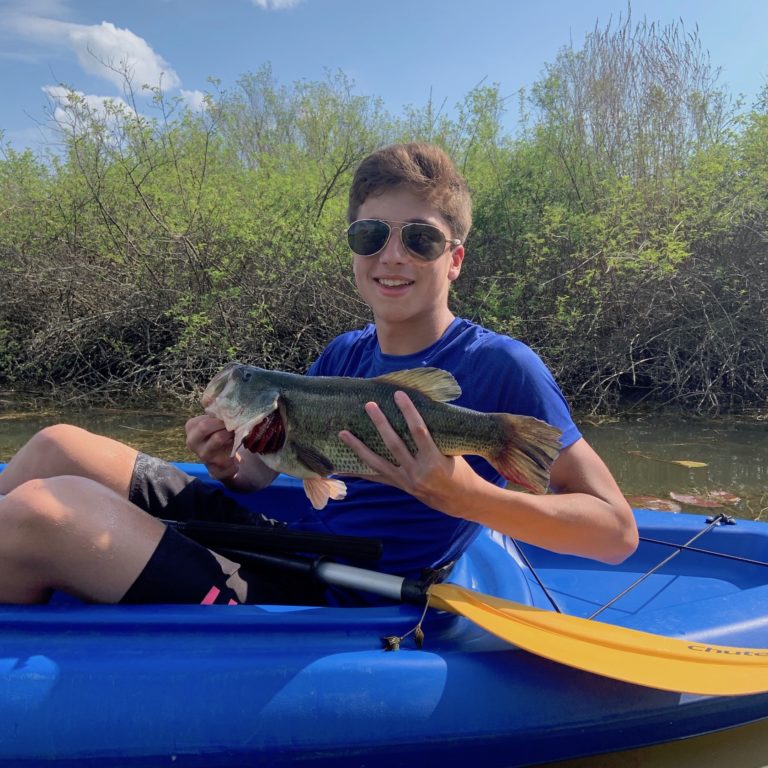The Largemouth Bass

The largemouth bass (Micropterus salmoides) is a warm-water sport fish found throughout western New York. Largemouth bass typically range between 10 and 16 inches in length and can be identified by their pale green coloration, the blotchy black stripe running from gill plate to tail, and their mouths, which are disproportionately large compared to the rest of their body.
Contrary to the belief of many, a largemouth bass is not a smallmouth bass with a big mouth, and a smallmouth bass is not a largemouth bass with a small mouth! The largemouth bass is a distinct species from the smallmouth bass, though they are both part of the sunfish family. Largemouth bass have much different body proportionality and coloration than smallmouth bass. The largemouth bass is probably the most popular sport fish in North America.
Habitat
Largemouth bass are warm-water fish and are pretty tolerant of warm temperatures. Given their adaptability, largemouth bass can be found in pretty much any body of water: streams, creeks, rivers, ponds, and lakes. The only place where largemouth bass might be hard to come by is cold, clean, well-oxygenated wild trout streams.
In lakes and ponds, smaller largemouth may inhabit weedy areas closer to shore, intermingling with the bluegill and pumpkinseeds. Bigger largemouth are usually found just outside of weed edges in ponds where they are the top predator. In large lakes, big largemouth roam weedy areas and the shallows close to shore. Largemouth bass can sometimes be the top predator in lakes. In creeks and rivers, largemouth bass can be found in slow moving sections, deep pools, and even flats as long as the water is slow.
Food
Largemouth bass will eat just about anything they can fit inside their oversized mouths. Largemouth bass will eat other fish including baitfish, small bluegill, and even other largemouth! Largemouth bass will also eat insects such as worms or any insect that falls onto the surface of the water. Largemouth bass will eat amphibians such as frogs and salamanders, crustaceans such as crayfish, and even snakes that venture too far from shore. Largemouth bass can even eat small mice.
Where to Catch Largemouth Bass
Largemouth bass can be found pretty much everywhere and are abundant in all counties of western New York. Largemouth bass are usually stocked in ponds and lakes in neighborhoods and public parks. Ponds and lakes that aren’t stocked will frequently have a self-sustaining population of naturally reproducing largemouth bass. Local ponds are probably the best place to target largemouth bass, where they can be seen cruising the shallows.
Late spring through fall is generally the best time to target largemouth bass. During the early months of spring, when ice is unsafe or gone and water is still cold, largemouth bass can be lethargic and tough to catch. During May into early June, largemouth bass, like bluegill, will occupy the shallows of ponds and lakes making nests and spawning. During the spawn, largemouth bass are not focused on feeding and are tough to catch. Usually starting in June, largemouth bass begin to feed and become more aggressive. To target largemouth at your local pond, fishing shallow weedy areas or just beyond the weed line is a good bet.

How to Largemouth Bass
Largemouth bass can be caught on pretty much any reasonably sized bait, artificial or live. The simplest rig for catching bass is a large piece of nightcrawler on a hook fished under a bobber with a small weight added about 6 inches from the hook. The only issue with the worm and bobber method is the ferocity of the bluegill that almost always snap up your bait before the bass can get to it.
Other good live bait for largemouth bass include minnows, chubs, and crayfish. Minnows, chubs, and crayfish can be fished under a float or on the bottom. When fishing live bait under a float, cast your bait out past the weed edge and slowly reel it in close to the weeds. Adjust the depth of your bobber or slip float to get your bait close to the bottom. When fishing a bottom rig cast your bait out and wait. Give your bait a couple twitches here and there to attract attention.
Spin fishing for largemouth bass on artificial lures is very productive. Bass will take a variety of lures including stick baits, soft plastic worms, minnows, and crayfish, spinner baits, in-line spinners, and jigs. When fishing stick baits, try to cast parallel to shore just beyond the weed line and keep your bait running close to the weed line when you retrieve it. Use a similar strategy when fishing soft plastics or spinners. Stick baits 3-6 inches long with a small lip are appropriate for most ponds.
Largemouth bass can also be taken on the fly. Good flies for largemouth include large surface poppers and streamers. On summer evenings, largemouth can be caught on surface poppers fished close to the weed line. Largemouth bass will usually respond to streamers 3-6 inches long in a variety of colors as well.
